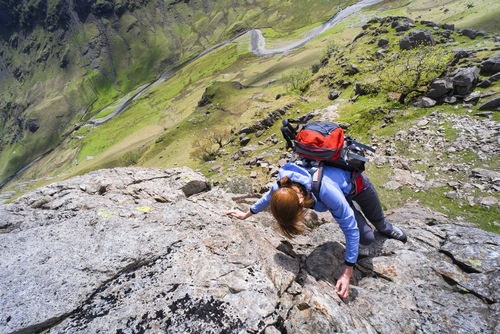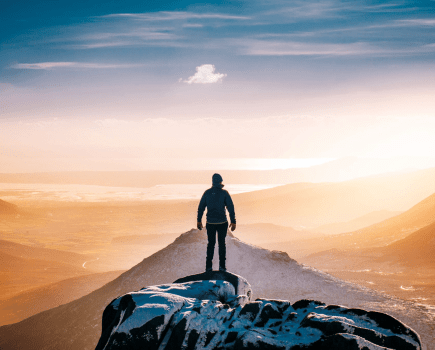Social media is swamped with daredevil ‘influencers’ performing risky stunts. But when scrambling and climbing guides use these tactics to market themselves, the results can be controversial – even dangerous. Hanna Lindon looks at a recent example.
Media personalities who market themselves through bravado-pumped videos are nothing new in the outdoors world. Bear Grylls was eating fish eyeballs and biting the heads off snakes before anyone had heard of Instagram. YouTube is swamped with films of ‘social influencers’ base jumping, dangling off skyscrapers and soloing nail-biting climbing routes.
We live in an age where some reckless adrenaline junkies are literally dying for the perfect Instagram shot. But what happens when the daredevil influencer risking life and limb on camera is marketing their services as a guide?
‘Brave Dave’
That’s the question that set the UKC forum buzzing recently. The catalyst was a video by Brave Dave, a Snowdonia-based Mountain Leader who had posted what many felt was reckless footage of himself leading a client up a grade 2 scramble without ropes and helmets.
“If this was a video of a couple of mates out scrambling it would not be of much concern, although the lack of helmets and evidence of any emergency gear such as a rope might deserve comment,” says Steve Long, Technical Officer at Mountain Training and author of the organisation’s hill walking handbook.
“But anybody offering guiding services has an enhanced duty of care. I would insist on a helmet for the client for a start. But to be honest, the bigger concern is that it’s all presented as if it’s all a jolly jape with no consequences if the client slips.”
Brave Dave took down the video following a slough of criticism and later posted an explanatory clip. He told The Great Outdoors that he acknowledges some of the safety concerns triggered by the original footage and agrees that he was leading on terrain that was beyond the remit of his qualification.
“I have since then altered some of the routes on which I take my more capable clients,” he added. “My justification for originally taking those clients on a grade 2 scramble is that grade 2 is a bit of a grey area in relation to safety procedures and so I felt it would be okay. Of course, nothing went wrong and my clients and I had a great time, but I understand the concern from others with more experience and have listened to what they had to say.”
The fight for ‘likes’
Whatever your take on the Brave Dave furore, there’s no doubt that his tough-talking, machismo-heavy style speaks to something in the public psyche. Some videos on his YouTube channel have garnered more than two million views and he commands up to £250 for a day of private guiding. As Dave argues, “my video style encourages average people to consider getting out into the mountains because my videos are real, raw and engaging.”
Rusty Bale of Snowdonia Walking and Climbing, himself a Mountaineering Instructor with a strong social media following, has noticed “a small but usually quite successful percentage” who market themselves in a similar way. While Dave relies on his own footage, other social media sensations “try to attract big numbers by using other people’s photos and posting corny quotes about challenging yourself.
“They appeal to the Tough Mudder crowd. But the thing about Tough Mudder is that it’s a really controlled environment. The mountains aren’t a controlled environment.”
There’s an argument that young guides operating in an influencer-obsessed age are under pressure to post click-bait. Certainly, having a strong social media presence is increasingly becoming a requisite.
“I think it’s essential for a professional guide to share content on social media,” says Alberto De Giuli, a Mountain Guide operating in the Alps and the Dolomites. “[It’s important to] get known and to create good relationships with people – who might become future clients – to let people know you love what you do as a profession, and to make them aware you are constantly out there.”
However, De Giuli believes that you can engage followers on social media without displays of bravado. He aims to “show the beauty you can find in the outdoors [and the] goals you can achieve if only you work hard for your challenge.”
Bale, who has over 18,000 Instagram followers, takes an even more laid-back approach. “I try to keep it totally real and let the mountains sell themselves,” he says.
Anyone’s an expert
Guides who promote themselves through pumpy social media marketing are guaranteed to get traditionalists hot under the collar – but there’s a more widespread hill safety issue posed by the likes of YouTube and Instagram.
“Anyone is free to upload what they like to social media channels,” says George McEwan, Executive Officer at Mountain Training Scotland. “The concerning thing is that, in some cases, the people who post things are influential because of the number of followers they have. That can be a good thing, if someone is competent, experienced and has been subject to peer review through training and assessment. But in a lot of cases, these people are self-appointed experts.”
The result is a minefield for mountain newbies looking for kicks in the hills but uncertain about how to get out there. However, Steve Long has the following advice for anybody looking to attempt anything above a simple ridge walk.
“If you want to hire somebody who has been trained and assessed to lead on this terrain, you should look for somebody who holds the Mountaineering and Climbing Instructor qualification or a British Mountain Guide. If you don’t need somebody who is trained to make the appropriate risk-management decisions but just provide charisma and willingness to go up front, people like Brave Dave can probably provide a very entertaining outing – as long as you don’t slip!”
And as for learning how to scramble by watching YouTube sensations strut their stuff, BMC Training Officer Jon Garside has an answer to that. “If you wanted to learn to skydive, you wouldn’t watch Mission Impossible.”







